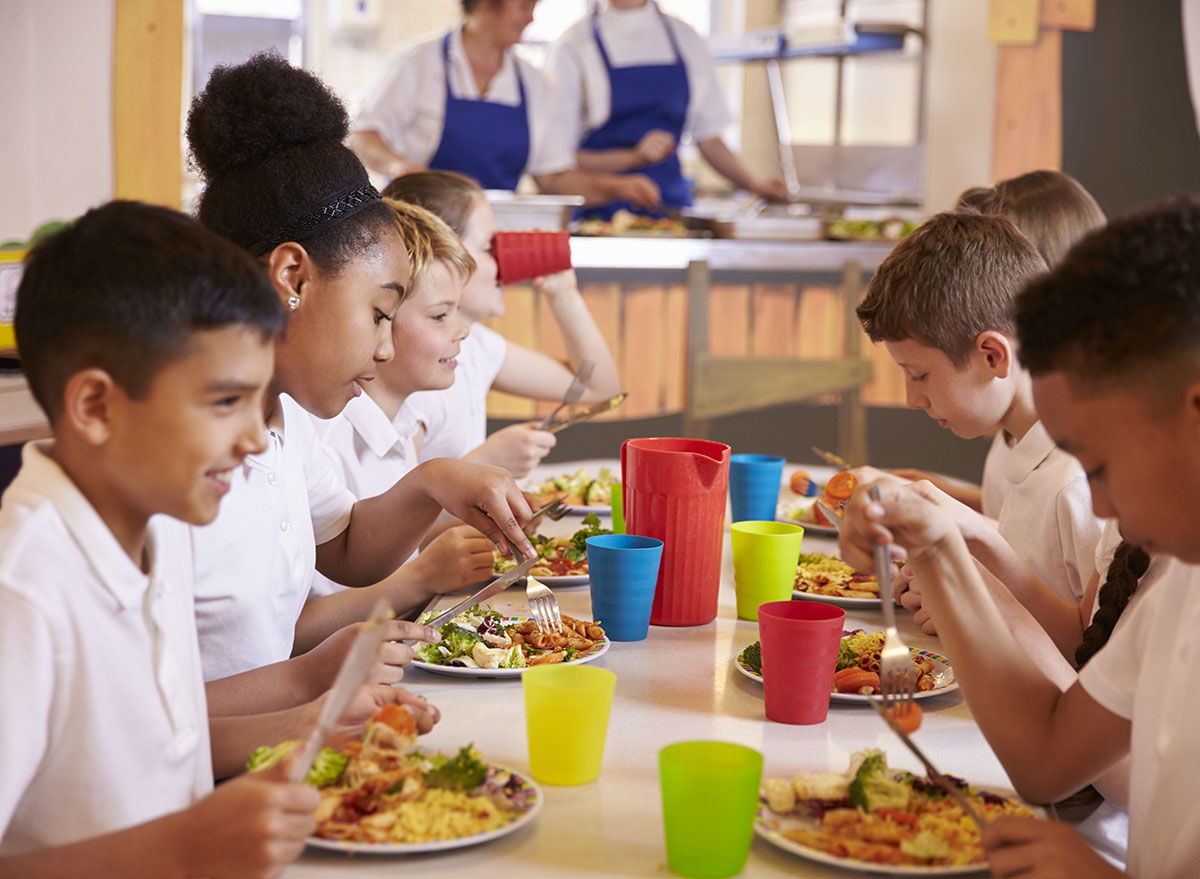The Single Biggest Change You'll See in School Cafeterias

The pandemic caused all schools to abruptly close, which, for many students, has taken away their access to a midday meal. Kids and young adults alike have had no choice but to finish their work online, and whether they'll be able to go back to school in the fall will depend heavily on the severity of the predicted second wave of coronavirus cases.
However, before discussing what will change cafeterias in the fall (in the event that it will be safe for students to return), it's important to first address what changes have already been made in order to keep children fed during these uncertain times. At the start of the pandemic, local restaurants were offering kids free meals due to school closures. Now, schools have been working diligently to keep students fed while at home.
STAY INFORMED: Sign up for our newsletter to get the latest coronavirus foods news delivered straight to your inbox.
How access to lunch has already changed for children
The National School Lunch Program provides free or reduced-price lunches to roughly 30 million children daily, but once schools were forced to shut down, many kids no longer had that meal.
A recent survey conducted by the National School Association gathered responses from nutrition professionals from more than 1,890 school districts nationwide and revealed that 80 percent are serving fewer meals during the pandemic, despite the fact that nearly all of them are still offering lunch.
As a result, the decline in revenue has negatively impacted schools' abilities to fund the packaging needed for grab and go meals, equipment for curbside pickup services, and even protective wear for the staff handing out the to-go meals.
In some districts, the price for to-go meals is pricier than what they would be in the cafeteria because of the additional distribution and packaging costs. While the slight increase in price is necessary to keep the school meal programs going, it inevitably makes it more challenging for low-income families to afford. In some cases, families may be without a consistent means of transportation to even pick up the meals.
The same survey also found that 43 percent of school districts are currently offering meals five days a week and will continue to do so throughout the summer. Other districts have the capacity to offer multiple days' worth of meals to families, which helps to minimize contact and reduce the number of times they need to get to the pickup sites.
As for the fall, what lunchtime will look like will likely vary by district.
The biggest change students will see in school cafeterias this fall
Diane Pratt-Heavner, a spokesperson for the School Nutrition Association, says that the CDC recently announced that they advise against children eating in the cafeteria at all. Instead, she says that lunch will be delivered to classrooms by way of a cart that's stacked with coolers.
Having lunch delivered would also mean that breakfast would be delivered too, which Crystal FitzSimons, Director of School and Out-of-School Time Program of the Food Research & Action Center, predicts could increase the number of kids who then eat breakfast.
"Breakfast in the classroom is an important strategy to increase participation, so this change could offer an opportunity to expand breakfast participation and allow more children to start the school day ready to learn," FitzSimons says.
According to the CDC's Interim Guidance for Administrators of US K-12 Schools and Child Care Programs, another potential solution would be to stagger lunch by class to limit mingling among students. This would be the case should it be a challenge for schools to completely suspend the use of the cafeteria. Ultimately, no one knows exactly what lunchtime will look like for students in the fall right now.
"It's hard to predict exactly what school lunch will look like, but many schools will try to create some kind of distance between students, which will likely reduce students standing in line together," says FitzSimons.
Some schools may even stagger the days on which students can come into the classroom. Pratt-Heavner says that certain districts may only allow kids in a few days of the week, in which case, "schools will explore options to provide take-home meals to ensure students have consistent access to healthy meals."
With the way unemployment rates are looking right now, SNA predicts that the students' need for meal benefits will only increase.
RELATED: Staggering Map Shows Just How Many Restaurant Workers Have Been Affected by U.S. Lockdown
What this will end up costing schools
Some 68 percent of the school districts that responded to SNA's survey said that directors of feeding programs anticipate substantial financial losses this school year.
"Congress must act to cover these losses so school meal programs have adequate funds to restock their kitchens and cover start-up costs for next school year," Pratt-Heavner says.
There's a lot that goes into keeping children fed in schools, and how lunchtime will look come fall will depend on many factors. An increase in school funding will be essential to give kids who are dependent on breakfast and lunch the nutrition they need to excel.
"School breakfast and lunch are critical educational and health supports, and for millions of struggling families they offer an important resource that helps keep hunger at bay," says FitzSimons. "With so many families losing jobs and wages due to the economic fallout of COVID-19, ensuring access to school meals when schools reopen will be critical to supporting families being impacted."








